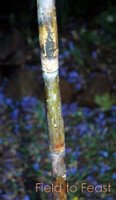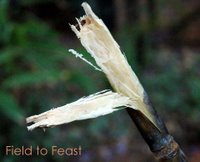 Road trips are 30 percent about getting to a destination, 30 percent about the journey, and 40 percent – heck, let’s forget math and make it 50 percent – about the food you eat along the way. In my years of roadtripping with friends and family, I’ve found that there are a variety of road-trip eating strategies.
Road trips are 30 percent about getting to a destination, 30 percent about the journey, and 40 percent – heck, let’s forget math and make it 50 percent – about the food you eat along the way. In my years of roadtripping with friends and family, I’ve found that there are a variety of road-trip eating strategies.
First, there are the snack packers. Zip-lock bags and Lil’ Playmate coolers at their service, snack packers stow away all sorts of nibbles that successfully pass the no-crumb, no sticky fingers that need to be washed test. Especially worthy snacks include crackers sandwiched around peanut butter and raisins (our snack of choice on a recent trip), Goldfish and seedless grapes. I feel certain a South African would add biltong, just as a Montanan would add beef jerky.
Then there are the risk-takers. Like a water diviner sensing an underground spring, risk-takers use gut instinct and a tug of intuition on their arm (right arm in the States, left in the UK, Australia, Zimbabwe, etc.) to indicate which exit they should use to pull off the highway. The food available at the exit is unknown. The risk-taker does not care.
Meanwhile, the plan-aheaders pre-select and carefully mark on the map each scheduled eating establishment, all of which are conveniently located at hunger-pang-spaced intervals. A final category of road-trip eater includes the people who see road trips as excuses to eat junk food, and, licking their greasy fingers, happily take advantage of these plentiful opportunities.
Growing up, we utilized a strageic road-trip combination of snack preparation (after all, who wants to be in a car with two hungry kids?), observation of the plan-ahead advice offered by AAA travel guides, and close scrutiny of the blue “Gas, Food, Lodging” signs by the side of the road. If it was mealtime and one of these signs indicated that there may be a local joint at the upcoming exit, we would stop. Only local restaurants – that was the rule. Chain restaurants were not allowed on road trips because, as my mother said, travel was for experiencing new things.
I speak of road trips because this past weekend Mark, a friend and I drove six hours southeast of Harare for a holiday in Gonarezhou National Park, which is situated along the border with Moz ambique. Although we packed some snacks (macadamia nuts, peeled carrots, apples and cereal bars made with baobab pulp), we also knew we could acquire more treats along the way, since, no matter how rural the area, in Zimbabwe you can always find people selling fruits and veggies by the roadside. That’s how we ended up with this sugar cane.
ambique. Although we packed some snacks (macadamia nuts, peeled carrots, apples and cereal bars made with baobab pulp), we also knew we could acquire more treats along the way, since, no matter how rural the area, in Zimbabwe you can always find people selling fruits and veggies by the roadside. That’s how we ended up with this sugar cane.
Sugar cane is, of course, used to make sugar. It can also be eaten fresh by peeling off the tough skin, tearing out the fibrous inside with your teeth,  chewing it, and sucking out all the sweet juice. Then, in a move that is hard to accomplish gracefully, you must spit out the well-masticated pulp and throw it out the window. My husband does all this much better than me, which is why he is in the photo. Sugar cane fills many road trip snacking needs, as it provides a quick sugar burst and the chewing keeps your jaw busy for a while. And, if you ask the nice woman who sells you the sugar cane to break it into smaller pieces, you won’t even make much of a mess in your car.
chewing it, and sucking out all the sweet juice. Then, in a move that is hard to accomplish gracefully, you must spit out the well-masticated pulp and throw it out the window. My husband does all this much better than me, which is why he is in the photo. Sugar cane fills many road trip snacking needs, as it provides a quick sugar burst and the chewing keeps your jaw busy for a while. And, if you ask the nice woman who sells you the sugar cane to break it into smaller pieces, you won’t even make much of a mess in your car.
Our road trip didn’t give us the option of junk food, exits or a variety of roadside eating establishments. It did however, give us sugar cane. Which means that, all in all, sugar cane helped make our road trip what it should be – a snack trip.
The top photo in this post was named "Best in Originality" in the October 2006 edition of "Does My Blog Look Good in This," a food blog event hosted by Spittoon Extra.
 Road trips are 30 percent about getting to a destination, 30 percent about the journey, and 40 percent – heck, let’s forget math and make it 50 percent – about the food you eat along the way. In my years of roadtripping with friends and family, I’ve found that there are a variety of road-trip eating strategies.
Road trips are 30 percent about getting to a destination, 30 percent about the journey, and 40 percent – heck, let’s forget math and make it 50 percent – about the food you eat along the way. In my years of roadtripping with friends and family, I’ve found that there are a variety of road-trip eating strategies. 
 chewing it, and sucking out all the sweet juice. Then, in a move that is hard to accomplish gracefully, you must spit out the well-masticated pulp and throw it out the window. My husband does all this much better than me, which is why he is in the photo. Sugar cane fills many road trip snacking needs, as it provides a quick sugar burst and the chewing keeps your jaw busy for a while. And, if you ask the nice woman who sells you the sugar cane to break it into smaller pieces, you won’t even make much of a mess in your car.
chewing it, and sucking out all the sweet juice. Then, in a move that is hard to accomplish gracefully, you must spit out the well-masticated pulp and throw it out the window. My husband does all this much better than me, which is why he is in the photo. Sugar cane fills many road trip snacking needs, as it provides a quick sugar burst and the chewing keeps your jaw busy for a while. And, if you ask the nice woman who sells you the sugar cane to break it into smaller pieces, you won’t even make much of a mess in your car.





2 comments:
It's not about food, but I would really love, really love, to hear about Gonarezhou.
It's a regret of mine that I never went there. It always sounded so perfectly beautiful and wild. Tell us when you get a spare moment.
Oh, and being Halloween this side of the world I can't wait to make your Pumkin Frtitters - look divine.
wow, its really a good trip.
Post a Comment